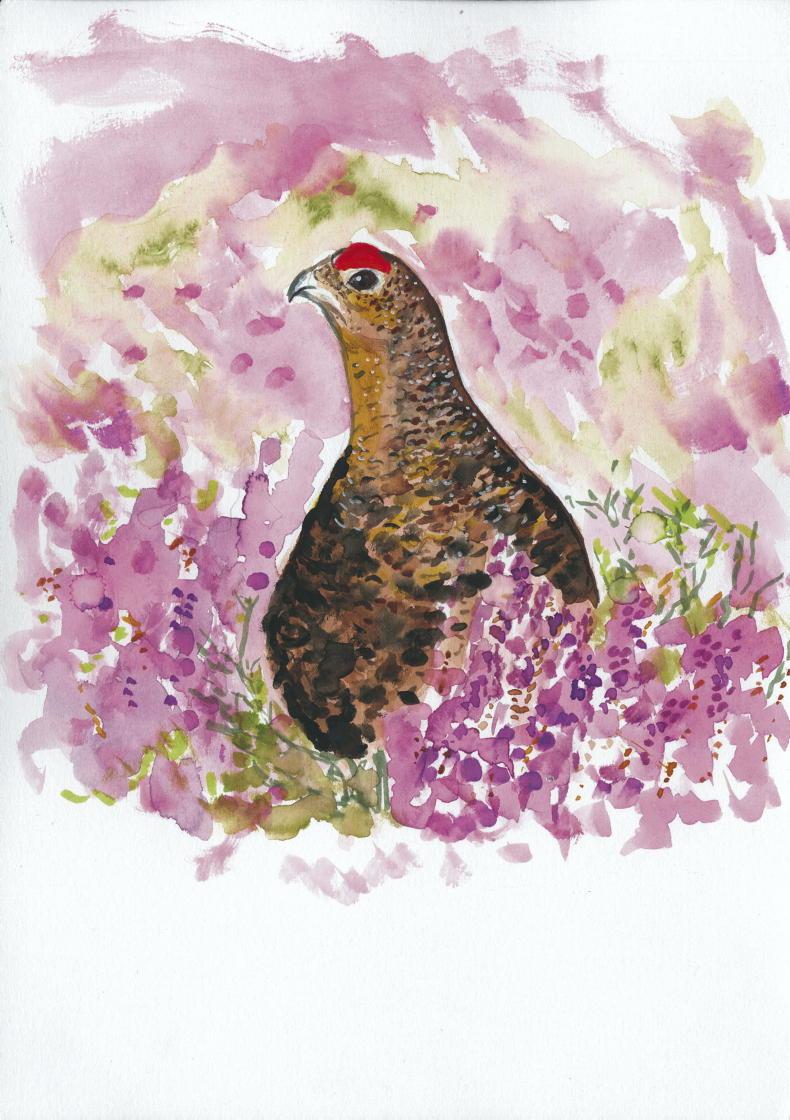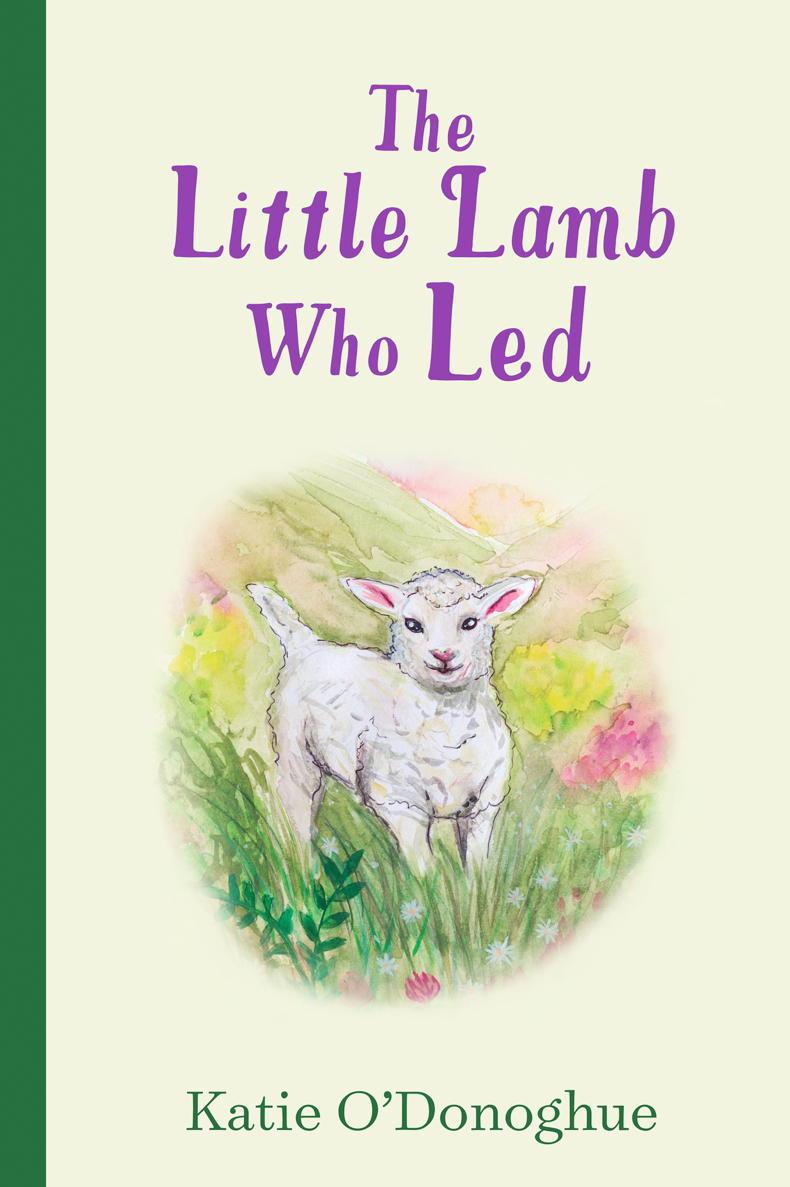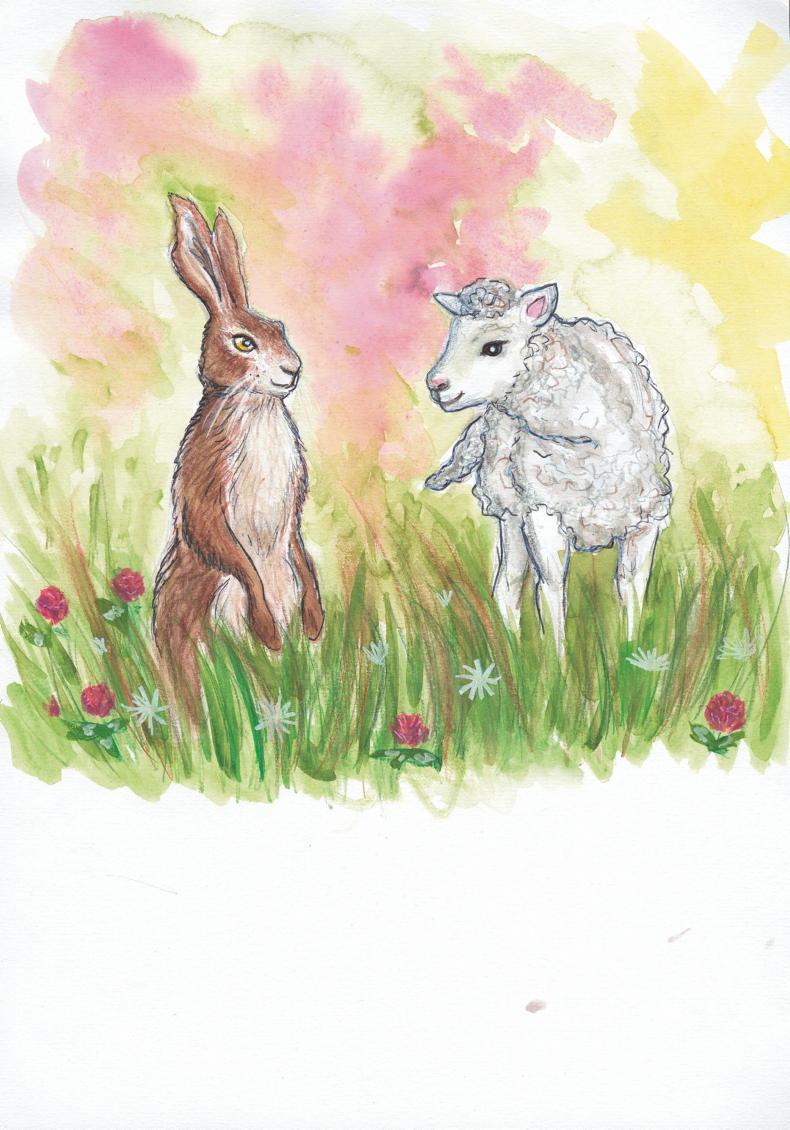As adults, reading a book can often bring us on a personal journey. We might connect with the story and characters and relate them to our own lives. Books can be emotional, funny, inspiring, and disturbing. A book can leave us with quite the impression; sometimes it can even be life-changing.
Imagine what the experience of reading is like for a child. How impressionable children are, and how learning stories through images and words is fascinating to them. Do they relate the stories from books to their lives? That is exactly what Katie O’Donoghue’s books aim to do. Katie, from the village of Beaufort in Co Kerry, is an accredited art psychotherapist with the Irish Association of Creative Art Therapists (IACAT) and the Irish Association of Psychotherapists and Counsellors (IACP).
Her new book, The Lamb Who Led, is a story about strength and courage set in the Irish countryside, which she wrote and illustrated. Through her work with young people, she has been inspired to create children’s books that support their well-being and foster interest in the natural environment. She is also the author of The Little Squirrel Who Worried and The Little Otter Who Tried.
Inspiration from nature
Katie was inspired by her native landscape, near the MacGillicuddy’s Reeks in Co Kerry, for The Lamb Who Led. The book features all the creatures you can see on and around the Kerry mountains. Along with the story, it includes fact files about each animal featured.
“I started the project as something for my own well-being during the pandemic,” says Katie. “My husband and I were living in the UK and I really missed home. I started doodling a little red squirrel, one of our native wildlife animals.
Speaking with parents from my work, I could see that these coping skills and psychoeducation was working, so I thought about turning the squirrel into a little story. I wasn’t planning on doing anything with it.
“I sent it to a member of my family by email one evening, not realising I had sent it to the wrong address. The next morning, there was an email in my inbox from a gentleman in Chicago. He said he had received my email, and after reading it, read the story to his six-year-old boy who had been in and out of therapy for anxiety. The child, at the end of the night, said to him – and apparently, he had never said this before – ‘Daddy, that was a really good bedtime story’. The man said that if I ever published the story to let him know. I’m still in contact with that family. It was the push that I needed, really.”

An illustration from The Little Lamb Who Led by Katie O'Donoghue.
Childhood inspiration
Art is something Katie has loved since she was a child. Luckily, she had adults around her who encouraged her to follow her path.
“One of my best memories is of my Junior Certificate teacher – who is one of the women I dedicated my second book The Little Otter Who Tried to – who was a pivotal adult in my life. She promoted that sense of self and being good at something and was really supportive. I think teachers have an amazing capacity to help shape young people’s lives and she was definitely that.”
Katie studied fine art and design in the Crawford College of Art and Design in Cork. “I enjoyed it, but for me, there was something missing,” she says. “It was the connection with people. While I was in college, I worked for an out-of-hours GP service. That definitely gave me awareness that people go through so much, that you really never know what somebody is going through. The combination of hearing different people’s experiences from things that were quite traumatic, like sudden deaths to mental health calls, made me realise that I wanted to be able to do something that helped others. A masters in art therapy was on offer in Crawford at that time and I was very happy to get a place.”

The Little Lamb Who Led, by Katie O'Donoghue.
Art as therapy
The Lamb Who Led, aims to help children understand their emotions, build their confidence and foster curiosity for Irish nature. This is done through the guise and clever combination of story and psychoeducation – supporting children in learning resilience and empathy.
“Art therapy is a psychological form of therapy, not unlike psychotherapy or counselling, but it utilises art and/or creative materials, so that individuals can, through the creative process, express their inner worlds,” she says.
“Through creation and reflection with a therapist, it can help us explore different difficult experiences or emotions. It supports people in emotional regulation and increased emotional awareness as well.
“It can be particularly useful for young children who don’t always have the words for their feelings or experiences but who can create an image to help them reflect on how they’re feeling. This is especially effective for trauma.
“As children, we learn to draw before we write, and it comes inherently to us. We don’t have the inhibitions or that critical self-judgement that tends to creep in as we get older. When I work with an adult, for example, a blank, white piece of paper can feel incredibly threatening and overwhelming, because they will say to me, ‘I’m not good at art’, or it’s because at some point in their life they were told they couldn’t draw.
“Art therapy isn’t about the aesthetics of what’s created. It’s the literal expression and how you feel making it. There’s no right or wrong and it’s a space without judgement. It’s really beautiful to witness an adult come back into their creativity and not be so critical of themselves. But children, innately, have no problem drawing. It is quite a privilege to witness how readily they can get stuck in.”
The Little Lamb Who Led is published by Gill Books, €13.99

An illustration from The Little Lamb Who Led by Katie O'Donoghue.
Katie’s advice for parents as the days get longer
‘As spring arrives, bringing warmer weather and longer days, many parents are looking forward to spending more quality time with their families. I think that we can simply start by taking our kids outdoors,” says Katie.
So, in what ways can our kids benefit from getting outside?
• Reducing stress – playing outside for just 20 to 30 minutes in the day has been evidenced to significantly decrease the stress hormone cortisol, while also lowering heart rate and blood pressure.
• Encouraging exercise – getting out and about with our little ones in nature provides them with the opportunity to run, jump, skip and hop. This helps release any anxiety or big feeling that have built up during the day while also supporting the development of muscle strength, releasing feel good endorphins and boosting their mood.
• Lowering anxiety – spending time in nature can be a grounding form of mindfulness. Taking a break from the business of life to simply be in the presence of the natural environment is not only a form of rest for the mind but being outdoors means exposure to natural light, which stimulates the body’s serotonin levels, another mood boosting hormone.
• Improved sleep – being in the sunlight helps regulate our circadian rhythm, in a sense, recalibrating our body’s internal clock. Who doesn’t feel better after a good night’s sleep?
Being in nature has so many benefits but most of all, children can play freely, be healthy and learn all about the natural world around them.”
Read more
Artist Fiachra Crowley is shaping his own future
Dr Marie Cassidy: inside the mind of a crime novelist
As adults, reading a book can often bring us on a personal journey. We might connect with the story and characters and relate them to our own lives. Books can be emotional, funny, inspiring, and disturbing. A book can leave us with quite the impression; sometimes it can even be life-changing.
Imagine what the experience of reading is like for a child. How impressionable children are, and how learning stories through images and words is fascinating to them. Do they relate the stories from books to their lives? That is exactly what Katie O’Donoghue’s books aim to do. Katie, from the village of Beaufort in Co Kerry, is an accredited art psychotherapist with the Irish Association of Creative Art Therapists (IACAT) and the Irish Association of Psychotherapists and Counsellors (IACP).
Her new book, The Lamb Who Led, is a story about strength and courage set in the Irish countryside, which she wrote and illustrated. Through her work with young people, she has been inspired to create children’s books that support their well-being and foster interest in the natural environment. She is also the author of The Little Squirrel Who Worried and The Little Otter Who Tried.
Inspiration from nature
Katie was inspired by her native landscape, near the MacGillicuddy’s Reeks in Co Kerry, for The Lamb Who Led. The book features all the creatures you can see on and around the Kerry mountains. Along with the story, it includes fact files about each animal featured.
“I started the project as something for my own well-being during the pandemic,” says Katie. “My husband and I were living in the UK and I really missed home. I started doodling a little red squirrel, one of our native wildlife animals.
Speaking with parents from my work, I could see that these coping skills and psychoeducation was working, so I thought about turning the squirrel into a little story. I wasn’t planning on doing anything with it.
“I sent it to a member of my family by email one evening, not realising I had sent it to the wrong address. The next morning, there was an email in my inbox from a gentleman in Chicago. He said he had received my email, and after reading it, read the story to his six-year-old boy who had been in and out of therapy for anxiety. The child, at the end of the night, said to him – and apparently, he had never said this before – ‘Daddy, that was a really good bedtime story’. The man said that if I ever published the story to let him know. I’m still in contact with that family. It was the push that I needed, really.”

An illustration from The Little Lamb Who Led by Katie O'Donoghue.
Childhood inspiration
Art is something Katie has loved since she was a child. Luckily, she had adults around her who encouraged her to follow her path.
“One of my best memories is of my Junior Certificate teacher – who is one of the women I dedicated my second book The Little Otter Who Tried to – who was a pivotal adult in my life. She promoted that sense of self and being good at something and was really supportive. I think teachers have an amazing capacity to help shape young people’s lives and she was definitely that.”
Katie studied fine art and design in the Crawford College of Art and Design in Cork. “I enjoyed it, but for me, there was something missing,” she says. “It was the connection with people. While I was in college, I worked for an out-of-hours GP service. That definitely gave me awareness that people go through so much, that you really never know what somebody is going through. The combination of hearing different people’s experiences from things that were quite traumatic, like sudden deaths to mental health calls, made me realise that I wanted to be able to do something that helped others. A masters in art therapy was on offer in Crawford at that time and I was very happy to get a place.”

The Little Lamb Who Led, by Katie O'Donoghue.
Art as therapy
The Lamb Who Led, aims to help children understand their emotions, build their confidence and foster curiosity for Irish nature. This is done through the guise and clever combination of story and psychoeducation – supporting children in learning resilience and empathy.
“Art therapy is a psychological form of therapy, not unlike psychotherapy or counselling, but it utilises art and/or creative materials, so that individuals can, through the creative process, express their inner worlds,” she says.
“Through creation and reflection with a therapist, it can help us explore different difficult experiences or emotions. It supports people in emotional regulation and increased emotional awareness as well.
“It can be particularly useful for young children who don’t always have the words for their feelings or experiences but who can create an image to help them reflect on how they’re feeling. This is especially effective for trauma.
“As children, we learn to draw before we write, and it comes inherently to us. We don’t have the inhibitions or that critical self-judgement that tends to creep in as we get older. When I work with an adult, for example, a blank, white piece of paper can feel incredibly threatening and overwhelming, because they will say to me, ‘I’m not good at art’, or it’s because at some point in their life they were told they couldn’t draw.
“Art therapy isn’t about the aesthetics of what’s created. It’s the literal expression and how you feel making it. There’s no right or wrong and it’s a space without judgement. It’s really beautiful to witness an adult come back into their creativity and not be so critical of themselves. But children, innately, have no problem drawing. It is quite a privilege to witness how readily they can get stuck in.”
The Little Lamb Who Led is published by Gill Books, €13.99

An illustration from The Little Lamb Who Led by Katie O'Donoghue.
Katie’s advice for parents as the days get longer
‘As spring arrives, bringing warmer weather and longer days, many parents are looking forward to spending more quality time with their families. I think that we can simply start by taking our kids outdoors,” says Katie.
So, in what ways can our kids benefit from getting outside?
• Reducing stress – playing outside for just 20 to 30 minutes in the day has been evidenced to significantly decrease the stress hormone cortisol, while also lowering heart rate and blood pressure.
• Encouraging exercise – getting out and about with our little ones in nature provides them with the opportunity to run, jump, skip and hop. This helps release any anxiety or big feeling that have built up during the day while also supporting the development of muscle strength, releasing feel good endorphins and boosting their mood.
• Lowering anxiety – spending time in nature can be a grounding form of mindfulness. Taking a break from the business of life to simply be in the presence of the natural environment is not only a form of rest for the mind but being outdoors means exposure to natural light, which stimulates the body’s serotonin levels, another mood boosting hormone.
• Improved sleep – being in the sunlight helps regulate our circadian rhythm, in a sense, recalibrating our body’s internal clock. Who doesn’t feel better after a good night’s sleep?
Being in nature has so many benefits but most of all, children can play freely, be healthy and learn all about the natural world around them.”
Read more
Artist Fiachra Crowley is shaping his own future
Dr Marie Cassidy: inside the mind of a crime novelist









 This is a subscriber-only article
This is a subscriber-only article











SHARING OPTIONS: